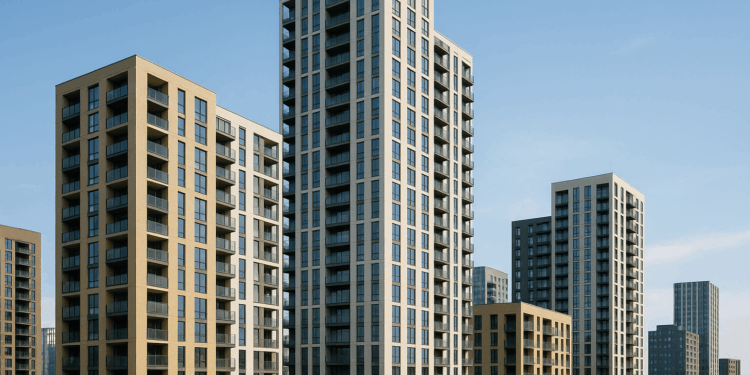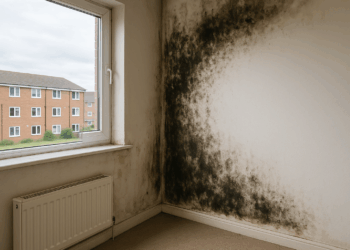Story Highlight
– High-rise buildings essential for meeting housing targets.
– Delays at Gateway 2 impact project approvals significantly.
– Average approval wait time now 36 weeks.
– Developers criticize ambiguity and submission challenges.
– Industry calls for drastic reforms and phased approvals.
Full Story
High-rise constructions play a pivotal role in the UK government’s housing strategy, especially in urban centres where demand for high-density living is acute. However, the implementation of the new building safety framework, established in light of the 2017 Grenfell Tower fire that resulted in 72 fatalities, has created significant challenges for the property sector.
The framework introduced the Building Safety Regulator (BSR) in 2022, which enforces a rigorous three-stage “gateway” approval process for high-rise developments encompassing planning, construction, and completion. Notably, applications submitted for Gateway 2 must comprise fully developed construction proposals, allowing no room for incremental submissions—a requirement that many in the industry find burdensome.
Although the construction and property sectors generally endorse the framework’s objectives, concerns about lengthy approval times have escalated. Recent statistics reveal that from January to March 2025, only 257 decisions were made at Gateway 2, amid a backlog of 1,276 applications. The average wait time now stands at 36 weeks, which is three times longer than the government’s intended benchmark. In London, the delays are particularly pronounced; just under half of the 2,148 housing projects initiated in the first half of the year involved buildings exceeding 18 metres, a stark drop compared to 71% in the same timeframe in 2019.
Mark Reynolds, executive chair of Mace Group, voiced concerns during a parliamentary inquiry in July, highlighting that the BSR’s requirements often exceed industry capacity. “The level of detail that was being asked, particularly at Gateway 2, was, quite frankly, beyond the capability of the system the industry works in,” he stated. He further called attention to the urgent need for reforms, referring to the current state as a “crisis.”
In response to rising discontent due to the backlogs, the government announced several reforms in June aimed at expediting the BSR processes. These measures include leadership transitions, increased investment, additional staffing, and a fast-track mechanism to improve the review of new build applications. The Ministry of Housing, Communities and Local Government, which oversees the BSR, affirmed its commitment to enhancing safety in buildings while addressing housing shortages. “That’s why we have announced a package of reforms to the Regulator to reduce delays and build the homes this country desperately needs — delivering on our Plan for Change,” a spokesperson noted.
However, industry leaders stress that more extensive reforms are necessary. Rebecca Taylor, managing director of Long Harbour, emphasised the need for a substantial reshaping of the approval process. “A more staged approval process is needed to allow spades to get into the ground earlier. Delays at Gateway 2 impact planning approvals, and that’s hitting investor confidence,” she argued.
Martin Samworth, chair of the RICS board, echoed this sentiment, advocating for a return to a more traditional phased approach that previously allowed for adjustments after initial planning consent.
Reynolds further suggested that the review process should be adapted to consider applications from organisations collectively rather than isolating individual requests. He foresaw a potential influx of applications from single entities in the near future, which could exacerbate current delays if the government’s targets are to be successfully achieved.
The sentiment among developers and investors is clear: clarity and reliability from the government and regulators are essential. “The government and the regulator need to provide clarity and certainty — both on application requirements and processing times,” a senior housebuilder executive stated. Without these assurances, ongoing projects are likely to face postponements as investment confidence continues to wane.






















The safety framework is vital, but 36 weeks at Gateway 2 is unsustainable if we want to deliver homes at scale. We need clearer guidance on submission requirements, better resourcing for review teams and a staged approvals route that secures core safety outcomes early while allowing detailed design work to continue. That approach would protect residents, reduce costly delays and give developers the certainty needed to invest.
Delays at Gateway 2 are creating real risks to project viability and to the wider housing supply. The safety framework is essential, but the current process is creating uncertainty for developers and for the many trades and suppliers who rely on steady work. A clearer, more consistent set of submission requirements and predictable timelines would reduce rework and cost, while a phased approvals approach would allow safe elements of construction to proceed sooner. The priority should be to maintain robust safety standards while streamlining administrative steps so that projects can move forward without compromising resident protection.
Lengthy Gateway 2 delays are a real bottleneck. The safety framework is needed, but clarity and consistency in requirements are just as important to avoid repeated resubmissions and wasted resources. A phased approval approach makes sense where early-stage compliance checks allow work to start on lower risk elements while detailed documentation for higher risk items is finalised. Improving guidance, dedicating trained review teams and setting firm turnaround targets would reduce uncertainty, speed delivery and maintain safety standards.
Lengthy Gateway 2 delays are undermining confidence and adding cost and uncertainty to projects that should be delivering homes. We need clearer, proportionate submission requirements and consistent regulatory timelines so that safety is maintained without freezing progress. A staged approvals approach that secures key safety sign offs early would let work begin on lower risk elements while detailed information is completed, helping to reduce backlog and get much needed housing built.